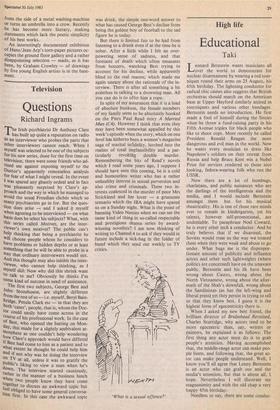Art
Influenced
John McEwen
The British Neo-Romantics 1935-1950 (Fischer Fine Art, till 19 August; National Museum of Wales, 27 August to 25 September) Graham Crowley: Home Comforts (Museum of Modern Art, Oxford, till 31 July; St Paul's Gallery, Leeds, 5-30 September; New 57 Gallery, Edinburgh, 10 March to 7 April 1984) Bill Woodrow: Beaver, Bomb and Fossil; Hans/Jean Arp; papier dechires; New Blood on Paper (Museum of Modern Art, Oxford, till 31 July)
nglish Neo-Romanticism as an artistic 1:4 category, however small an entry it may warrant in the history of art, is clearly here to stay, as the semi-official exhibition organised by Fischer Fine Art and the Na- tional Museum of Wales demonstrates. Artistic categories are no more than public conveniences, and bear as little scrutiny, but at least in this case a nomination, if not this particular appellation, appears justified. The artists usually referred to as the Neo-Romantics — and they form only a ham sliver in this historical sandwich of a show — do exhibit a common style and preoccupation.
'I was caught up in the wave of the English watercolour nationalist romantic patriotic isolationist self-preservationist movement' wrote the painter William Scott (in 1972) of his wartime brush with Minton, Ayrton and Craxton who, most convincingly, seem of an artistic
piece at Fischer — in contrast with the makeshift historical supporting cast, from Blake to Moore, on which the organisers rest the Neo-Romantic claim. Blake (via Palmer) had an influence on the early et- chings of Sutherland, and Sutherland, of thorny form and inky darkness influenced Ayrton, Minton and Craxton, but this is Sutherland himself under the influence of the Parisian avant-garde and most of all Picasso; it has nothing to do with the bucolic vision of Palmer and nor does the in- variably threatening mood of Neo- Romanticism in general, hinting as it always seems to at the agony — however much un- seen or unstated — of war. As for peaceful Hitchens, Pasmore and, essentially, Moore and Piper, their inclusion only adds to the confusion. But it is interesting to be shown what subsequent abstractionists like Prunella Clough and William Scott were IM to in their figurative youth, and sobering to see how fossilised, art-historically, the pro- duct of that relatively recent time already is.
Graham Crowley (b. 1950) and Bill Woodrow (b. 1948), painter and sculptor respectively, form a strong and visually sympathetic double bill at Oxford: both are newly successful, both inspired by in- dustrial products. Crowley's exhibition marks the end of this year as artist-in- residence at Oxford (benefactors St Ed- mund Hall, the museum, the Arts Council), the 15 oil paintings and 18 charcoal draw- ings on show having all been completed during his term of office. The great discovery of the last year for him has been the art of glazing, the process of applying a transparent — varnish-like — layer of oil paint over a solid one so that the colour of the first is modified. Completing the com- position first in tones of grey is another old masterish method beneficially adopted. This combination of grisaille and glazes sharpens and illuminates the work, making the result in every case more powerful and unified. The subject-matter — human strife (as before), humorously and alarmingly enacted by apparently animate inanimate objects (televisions, can-openers, meat grinders, motorbike parts) painted in the meaty style of Walt Disney Studios, even to windowed glimpses of Pinocchioville — also benefits. It is a child's view of the world — secretive, frightening, mysterious, enlarged, distorted — painted now with the dash and assurance of maturity.
Bill Woodrow's exhibition, being a retrospective, does not have the benefit of such novelty — the most up-to-date pieces having already been seen this year at the Lisson Gallery. Woodrow is emerging as the most popular of the new wave of English sculptors — to be largely featured these summer holidays at the Hayward and Serpentine — who use urban litter as their material. His transformations are par- ticularly ingenious and therefore enjoyable in themselves — in much the same way as concrete poems can be — but he is surely best when, in the traditional sculptural way, he releases 'the form within the stone'; when, for instance, he cuts a twangy guitar
from the side of a metal washing-machine or turns an umbrella into a crow. Recently he has become more literary, making statements which lack the poetic simplicity of his best works.
An interestingly documented exhibition of Hans/Jean Arp's torn-paper pictures oc- cupies the ground floor gallery and a rather disappointing selection — made, as it has been, by Graham Crowley — of drawings by five young English artists is in the base- ment.







































 Previous page
Previous page